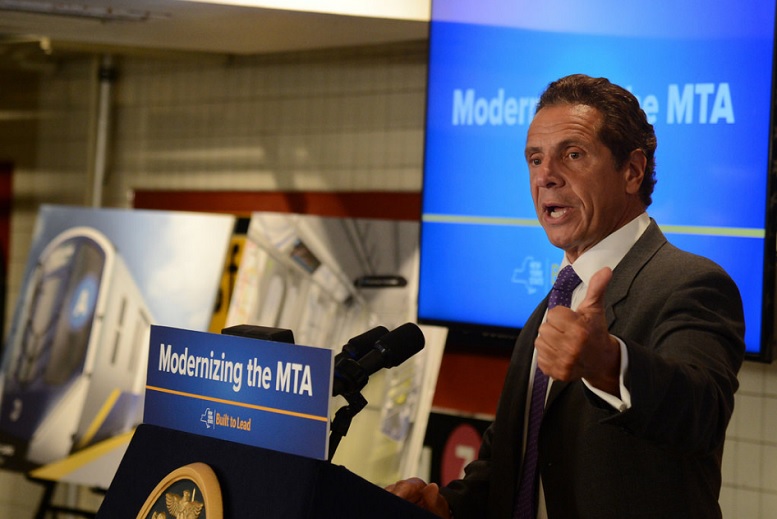There’s been a wide range of transportation issues to talk about in New York this year, from a new bridge rising on the Hudson to the forthcoming completion of three new subway stations, and everything in between. 2016 might be remembered as the year Governor Andrew Cuomo started paying attention to transportation, with speeches about new high-tech buses, the “Empire Station” complex and open-road tolling. But it could also be remembered as the year Vision Zero progress stalled. Here’s the good, the bad and the ugly of New York transportation in 2016:
The Good
Signature moments for streets and transit, from a highway transformation and bike share growth, to restored service and new subway stations
In 2016, Citi Bike undertook another major expansion and broke its own ridership record nine times. And that increase in people on bikes resulted in some additional dedicated bicycle infrastructure: the New York City Department of Transportation installed new bike lanes on the Upper East Side against the wishes of local NIMBYs (and Woody Allen), protected bike lanes on Jay Street, Amsterdam Avenue and Sixth Avenue, and a two-way cycle track on Chrystie Street, making it possible to ride from Brooklyn to the Bronx in a protected bike lane.
There was solid progress toward safer streets outside the city too. Rochester’s East Inner Loop is being transformed into a multimodal urban boulevard with some land set aside for development, serving as an example for other cities in the state. While there’s still more work to be done, traffic patterns are already changing. And in Albany, Governor Cuomo and the New York State Department of Transportation released a Pedestrian Safety Action Plan this year, with $110 million being dedicated to pedestrian safety. The plan identifies 20 priority areas, and will consider the presence of transit near crash sites, a crucial element given the high rate of fatalities within a half-mile of transit stations.
And although the Second Avenue Subway won’t officially open until 2017, there was one change on the New York City subway map this year (though you’d have to look pretty closely to notice). The W train, which was retired in 2010, returned in November and runs between Astoria and the southern tip of Manhattan.
Increased strength in leadership and transparency
In the first half of 2016, New York City had just one person — NYC DOT Commissioner Polly Trottenberg — representing its interests on the MTA Board. But in June, after a lengthy wait, the state senate finally confirmed David Jones, Executive Director of the Community Service Society of New York, as well as TSTC Executive Director Veronica Vanterpool, forming a “fiesty new bloc” on the board. Also in 2016, TSTC board member (and former staffer) Ya-Ting Liu was named executive director of Friends of the Brooklyn Queens Connector.
NYSDOT passed a five-year capital plan in April, its biggest ever, and by August the department (finally) released its project list. It was a long time coming, but it’s a win for transparency, and it helps bring about and end to the behind-the-scenes decision-making that has been so dominant in New York State policy making.
The Bad
Transportation planning has become a war of wills, and project financing remains shrouded in mystery
We were happy to hear this past spring that the Port Authority Bus Terminal replacement would be included in the Port Authority’s 10-year capital plan. Unfortunately, not much progress has been made since then. The Board of Commissioners struggled to find consensus on where the new terminal should be located, a disagreement that eventually came to a head last month in a war of words between New York elected officials and Port Authority Chairman John Degnan.
Notwithstanding the merits of projects such as Penn Station and the Long Island Rail Road “Third Track,” we’re still a little unclear on how some of Governor Cuomo’s recently-announced transportation initiatives will be paid for. And it’s not just the ones that haven’t yet broken ground; more than three years since construction began on the new Tappan Zee Bridge, we still don’t know how it’s being financed.
Declining bus service (and ridership) illustrates the need for comprehensive changes to bus transit
New York City has watched bus ridership decline by 16 percent since 2002, so a group of transit advocates launched a campaign to rethink the city’s bus network from top to bottom. New York City wasn’t alone with its rubber-tire transit struggles: Long Island’s Suffolk County Transit cut eight bus routes this past fall, while the Nassau Inter-County Express (NICE) bus system, which had considered axing some routes, was able to narrowly avoid making those cuts.
The Ugly
We’re going backwards, and in more than one way
In 2016, it took less than nine months for New York City bicyclist deaths to surpass the total number of bicyclist deaths in all of 2015. One fatal crash that stood out was the July 2 hit-and-run death of Matthew von Ohlen. The NYPD finally arrested the suspect on November 15, but not before launching a ticket blitz on cyclists in the same Brooklyn precinct in which von Ohlen was killed.
Meanwhile, a reality TV star from New York City was somehow elected president, and he’s already begun bankrupting his hometown. Donald Trump filled his cabinet with climate change deniers and a HUD Secretary with no housing policy expertise whatsoever, but on top of that, New York City residents — who voted overwhelmingly for someone else — may have to cover the bulk of the costs for the gridlock-creating security perimeter around his gold-plated skyscraper on Fifth Avenue.


[…] Tri-State Reviews the Good, the Bad, and the Ugly of 2016 […]